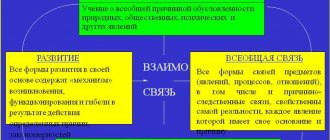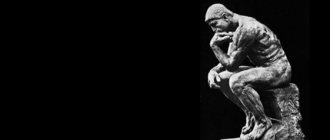Hello, dear readers of the KtoNaNovenkogo.ru blog. This concept was born in Ancient Greece and means counterintuitive opinion.
In a broad sense, the word paradox is a phenomenon, situation, event that seems incredible and does not correspond to people’s usual ideas about reality due to an unusual context.
What is the essence of paradoxes?
The easiest way is to understand what paradoxes are and what their essence is, you need to consider a few simple and banal examples. Let's take, for example, the familiar Windows operating system. In this operating system, in order to turn off the computer, you need to go to the “START” menu and there click on the “Shut down” button. In this case, the essence of the paradox is that in order to turn off the computer, we initially need to press the “START” button.
Another example of a good logical paradox is the following simple statement: “I always lie.” If you think about this phrase, then natural questions arise like:
- If the person who said this phrase really always lies, then he lied about the fact that he always lies, and is this true?
- But if this is true, then why does a person claim that he always lies. It would be a lie, wouldn't it?
As a result, from this example of a logical paradox we can draw a simple conclusion: If this is true, then it is not true.”
Logic and philosophy
A typical example of a logical paradox is the ship “Theseus” from a famous riddle in philosophy. This riddle asks whether the ship will be repaired over time if all its parts are replaced, and whether it will remain the same ship after that, or will it be a completely different object. Paradoxes can also take the form of images or other media. For example, in many of his drawings Escher used perspective paradoxes with walls that are considered floors from other perspectives and stairs that seem to have an infinite length.
The best logical paradoxes that will make you use your brain:
Achilles and the tortoise - Zeno's Paradox.
The Achilles and Tortoise Paradox is one of a number of theoretical discussions about motion put forward by the Greek philosopher Zeno of Elea in the 5th century BC. It all starts when the great hero Achilles decides to compete with a turtle in a race. To be fair, he agrees to give the turtle a 500-meter lead. When the race begins, it is not surprising that Achilles begins to run at speeds far exceeding the speed of a tortoise. By the time he reached the 500 meter mark, the turtle had only gone 50 meters further than him. By the time Achilles reached the 550 meter mark, the tortoise had walked another 5 meters. Further, when he reached 555 meters, the turtle walked another 0.5 m. Then 0.25 m, then 0.125 m, and so on. This process continues again and again to an endless series of smaller and smaller distances. At the same time, the tortoise always moves forward, and Achilles always plays catch-up.
From the point of view of this logic, it seems that Achilles will never be able to outrun the tortoise. Whenever he reaches the place where the turtle was, he will always have some distance, no matter how small he may be. But, in reality, we know that he can easily outrun the turtle. The trick to the paradox is that you shouldn’t focus on distances and the number of times you measure. The point is that, following this logic, any finite value can always be divided an infinite number of times, no matter how small its divisions may be.
Card paradox.
Imagine that you are holding a conditional card (a piece of paper) in your hand. On one side it says, “The statement on the other side of this card is true.” Let's call this statement “A”. Turn the card over. On this side it says: “The statement on the other side of this card is - false” (Statement B). However, trying to assign any truth to statement “A” or “B” leads us to a paradox. If "A" is true, then "B" must also be, but for "B" to be true, "A" must be false. Conversely, if "A" is false, then "B" must also be false, which should ultimately make "A" true.
Invented by British logician Philip Jourdain in the early 1900s, the Card Paradox is a simple variation of the so-called Liar Paradox that we mentioned at the beginning of the article.
Dichotomous paradox.
Imagine that you are going to walk down the street. To get to the other end, you first have to walk halfway there. And to get halfway there, you first have to walk a quarter of the way. To get a quarter of the way there, you first need to walk an eighth of the way. Then the sixteenth, then the thirty-second, sixty-fourth part of the way there and so on. Ultimately, to complete even the simplest tasks, such as walking down the street, you need to complete an infinite number of small tasks - which, by definition, is completely impossible. No matter how small the first part of the path is, it can always be halved to create another task. The only way you can't cut the distance in half is to treat the first part of the journey as having absolutely no distance. But, if we have to move without a distance, then we cannot even start the hike to the designated place.
Kinds
There are two main types of such phenomena. Let's talk about the first one first. A verical paradox is something that produces a result that seems absurd but is nonetheless presented (and appears) to be true. Thus, Frederick's birthday paradox in The Pirates of Penzance establishes the astonishing fact that a 22-year-old man would only have five birthdays if he were born on Leap Day. Likewise, the no-shooting theorem demonstrates the difficulty in mapping voting results to the will of the people. In 20th-century science, Hilbert Grand's paradox and Schrödinger's cat are prime examples of theories that draw a paradoxical rather than a logical conclusion.
A falsified paradox establishes a result that not only appears false, but actually is false. Various invalid mathematical proofs (such as 1 = 2) are classic examples, usually relying on hidden division by zero. Another example is the inductive form of the horse paradox, which falsely generalizes from true specific statements. "Zeno's paradoxes" are precisely "falsified", concluding, for example, that a flying arrow never reaches its target or that a fast runner cannot catch up with a turtle with an initial head start for the latter.
Time paradoxes.
There is nothing in Einstein's theory of relativity that would rule out time travel, although the very notion of traveling into the past violates one of the most fundamental premises of physics. Namely, causality. Considering the laws of cause and effect, there are naturally a number of inconsistencies and paradoxes associated with time travel. So, we may encounter the following paradoxes:
The paradox of predestination.
The predestination paradox occurs when the actions of a time traveler become part of past events. Which could ultimately cause the event he is trying to prevent. This results in a "causality time loop" in which event 1 in the past affects event 2 in the future, which then causes event 1 to occur. This circular loop of events ensures that history is not altered by the time traveler. Any attempts to stop something in the past will simply lead to the cause itself, and will not stop it. This paradox says that everything should always happen the same way, and whatever happens, must happen.
Examples of the paradox of predestination can be seen in the following films:
- 12 Monkeys (1995);
- Time Loop (2007);
- The Time Traveler's Wife (2009);
- Predestination (2014);
- Time Machine (2002).
The paradox of the murdered grandfather.
This time paradox gives rise to a “self-consistent solution.” Because if you went back in time and killed your grandfather, you would never have been born and you would not be able to go back in time - a paradox. Let's say you decide to kill your grandfather because he created a virus that practically destroyed the entire world. You figure that if you kill him before he meets your grandmother. The entire family line (including you) will disappear, but the world will remain intact. According to theoretical physicists, such a situation is impossible. Even if you can go back in time, all your attempts to harm your grandfather or change history will not be successful. The gun will jam, someone else will drink the poison, and so on.
But it is worth noting that if we take into account the hypothesis of multiple universes, then it is possible to kill grandfather in the past. You pull the trigger and boom! It is done. You return to the “present”, but you were never here. Everything about you has been erased, including your family, friends, home, property, bank account and history. You have entered a timeline where you never existed. Scientists believe that you created an alternate timeline or entered a parallel universe.
Paradox: Let's kill Hitler.
Like the Grandfather Paradox, which paradoxically prevents your own birth, the Hitler Killing Paradox erases the reason to go back in time to kill him. Besides the limited butterfly effect that killing Grandpa might have, killing Hitler would have far-reaching consequences for everyone in the world. The point is, if you killed Hitler, none of his crimes would go down in history and make you want him dead.
The connection between logic and language
Paradoxes that are not based on latent error usually occur at the periphery of context or language and require expansion of context or language to lose their paradoxical quality. Paradoxes arising from apparently intelligible uses of language are often of interest to logicians and philosophers. "This sentence is false" is an example of the famous paradox of lying: it is a sentence that cannot be interpreted as true or false, because if it is known to be false, then it is known that it must be true, and if it is known to be true, then it is known that it must be false. Paradoxes in psychology are often based on such strange thought experiments. Russell's paradox, which shows that the concept of the collection of all those sets that do not contain themselves leads to a contradiction, played an important role in the development of modern logic and set theory.
Paradoxes in literature.
In literature, Paradox is a tool a writer uses to present the unique features of a particular situation. It is used to make the audience look at a situation in detail and think about what is happening. Because the situation in the paradox is contradictory, it causes pause in reading for additional understanding.
Examples of paradoxes in literature.
In fact, you can find a huge number of examples, but we will focus on the works of George Orwell:
- In the text of the dystopian novel "1984", the party's motto is: " War is peace, freedom is slavery, ignorance is strength ." For any person, these statements are absurd and therefore paradoxical. However, for the characters in 1984, this is considered true. Orwell skillfully uses paradoxes to show the dominance of the party, and further enhance the atmosphere of dystopia;
- In the novel Animal Farm there is a phrase that is part of the “modified” commandments of “bestialism.” It is: " All animals are equal, but some are more equal than others ." This statement, at first glance, does not make any sense. However, upon closer examination, it becomes clear that Orwell is pointing to a political truth. The government in the novel claims that everyone is equal, but it never treated everyone equally. The concept of equality expressed in this paradox contradicts the general belief in equality.
Paradox and Oxymoron: what is the difference?
Many may have noticed that the definition of the term “paradox” is very similar to the definition of an oxymoron. The thing is that these two concepts are in some sense related. The point is that:
- Paradox is a term that represents a situation in which two events are unlikely to coexist;
- An oxymoron is paradoxical in nature, but it represents a figure of speech rather than a situation or event.
In simple words, the difference between a paradox and an oxymoron is that a paradox is an event or situation, while an oxymoron is a figure of speech.
Hidden error
Imagine a simple situation: a father and his son are driving along the road. The car crashes into a tree and the father dies. The boy is rushed to a nearby hospital where he is prepared for emergency surgery. Entering the office, the surgeon says: “I cannot work with this boy, he is my son.”
The apparent paradox is caused by a hasty generalization, since if the surgeon is the boy's father, the statement cannot be true. The paradox is resolved if it turns out that the surgeon is a woman, that is, the boy’s mother.











